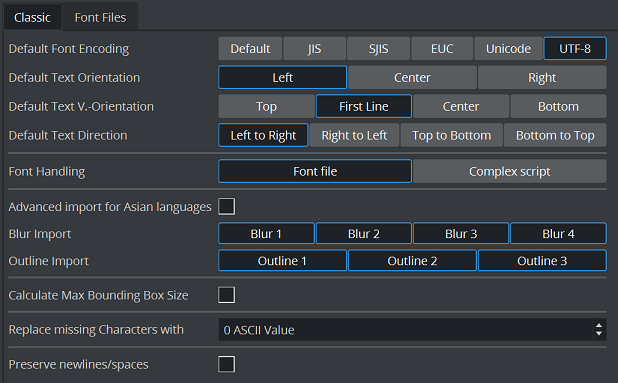
Viz Engine Administrator Guide
Version 5.2 | Published March 20, 2024 ©
Font and Text Options
In this section, there are two tabs.
-
Classic
-
Viz Engine
Classic
In this tab, the font and text options for Classic Render Pipeline can be configured.

-
Font encoding. Available options are:
-
Default: Sets the font encoding to single character interpretation (limited to 255).
-
Japanese Industry Standard Code (JIS): Sets Japanese industry standard code character encoding.
-
Shifted Japanese Industry Standard Code (SJIS): Sets the newer Shift JIS character encoding standard which sets aside certain character codes to signal the start of a two-character sequence.
-
Extended Unix Code (EUC): Sets Extended Unix Code (EUC) character encoding that is a multi byte character encoding system used primarily for Japanese, Korean, and simplified Chinese.
-
Unicode: Sets the Unicode character encoding where every two characters are inter-operated as one (not widely used).
-
UTF-8: Sets UTF-8 (8-bit UCS/Unicode Transformation Format) character encoding that is a variable-length character encoding for Unicode (default).
-
-
Default Text Orientation: Sets the default horizontal text orientation.
-
Default Text V. Orientation: Sets the default vertical text orientation.
-
Default Text Direction: Sets the default text direction.
-
Font Handling: Defines how fonts are handled.
-
Font file: Sets the font kerning to Font file that is mainly used for languages written from left to right.
-
Complex script: Sets the font kerning to Complex script. Complex script is mainly used for languages written from right to left, or when one character is composed of one or several glyphs.
IMPORTANT! With font handling in Complex Script mode, all fonts used must be installed in Windows to avoid unpredictable text behavior.
-
-
Advanced Import for Asian Languages: Imports fonts to be used with special features (including vertical text and EUDC) when enabled. This feature is useful for some Asian languages. The fonts must be installed in the operating system.
-
Font Import: Sets the Font import. Available options are; File (Standard) and Windows (Advanced).
-
File (Standard): Imports and stores fonts on the database.
-
Windows (Advanced): Stores only the font name on the database. For this to work the font must be installed on the Windows system where Viz Engine resides.
-
-
Blur Import: Enables blur levels for imported fonts. These options are used for Classic fonts only.
-
Outline Import: Enables outline levels for imported fonts. These options are used for Classic fonts only.
-
Calculate Max Bounding Box Size: Enables Viz Artist/Engine 3.x to calculate the bounding boxes as they were calculated in older versions. In Viz Artist/Engine 3.x a text object’s bounding box height increases if a capital character is entered (for example, an umlaut (double dots)). In Viz Artist/Engine 2.x, the bounding box height was always the same and independent of the characters in the text object. Available options are Active and Inactive. Default is Inactive (false).
-
Replace missing Characters with: Replaces a missing font character in a font file with a default font character. The Unicode value refers to the decimal value of the replacement character in the Unicode table (valid values are 0-65553). Normal usage would select a (42) or (95).
-
Preserve newlines/spaces: Does not remove spaces and newlines at the end of the text when saving and reloading a scene when set to Active. This influences bounding boxes. The default state is Inactive.
Viz Engine
In this tab, Font and Text options for Viz Engine Render Pipeline can be configured.

-
Default Import Path: A default location in Graphic Hub to which the font importer imports new FONT_FILE(FL) or FONT_FACE(FF).